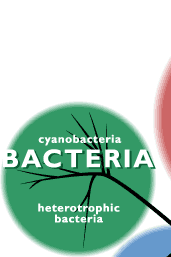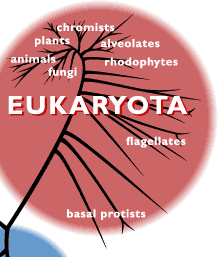UCMP Phylogeny Wing:
The Phylogeny of Life
The ancestor/descendant relationships which connectall organisms that have ever lived.
The Biosphere: Life on Earth
Life! It's everywhere on Earth; you can find living organisms from the poles to the equator, from the bottom of the sea to several miles in the air, from freezing waters to dry valleys to undersea thermal vents to groundwater thousands of feet below the Earth's surface. Over the last 3.7 billion years or so, living organisms on the Earth have diversified and adapted to almost every environment imaginable. The diversity of life is truly amazing, but all living organisms do share certain similarities. All living organisms can replicate, and the replicator molecule is DNA. As well, all living organisms contain some means of converting the information stored in DNA into products used to build cellular machinery from fats, proteins, and carbohydrates.
Three Domains of Life
|
Click on a domain to begin exploring. |
||
 |
 |
|
 |
||
Until comparatively recently, living organisms were divided into two kingdoms: animal and vegetable, or the Animalia and the Plantae. In the 19th century, evidence began to accumulate that these were insufficient to express the diversity of life, and various schemes were proposed with three, four, or more kingdoms. The scheme most often used currently divides all living organisms into five kingdoms: Monera (bacteria), Protista, Fungi, Plantae, and Animalia. This coexisted with a scheme dividing life into two main divisions: the Prokaryotae (bacteria, etc.) and the Eukaryotae (animals, plants, fungi, and protists).
Recent work, however, has shown that what were once called "prokaryotes" are far more diverse than anyone had suspected. The Prokaryotae are now divided into two domains, the Bacteria and the Archaea, as different from each other as either is from the Eukaryota, or eukaryotes. No one of these groups is ancestral to the others, and each shares certain features with the others as well as having unique characteristics of its own.
Within the last two decades, a great deal of additional work has been done to resolve relationships within the Eukaryota. It now appears that most of the biological diversity of eukaryotes lies among the protists, and many scientists feel it is just as inappropriate to lump all protists into a single kingdom as it was to group all prokaryotes. Although many revised systems have been proposed, no single one of them has yet gained a wide acceptance.
 A fourth group of biological entities, the viruses,
are not organisms in the same sense that eukaryotes, archaeans, and bacteria
are. However, they are of considerable biological importance.
A fourth group of biological entities, the viruses,
are not organisms in the same sense that eukaryotes, archaeans, and bacteria
are. However, they are of considerable biological importance.
In all cladograms in our exhibits, if there is a picture within a box, that means we have an exhibit on the taxon. If your favorite organisms aren't here yet, keep trying: since there may be as many as 100 million living and fossil species of organism, it may take us a little while to cover all the highlights. For more information on finding your way around in our phylogeny exhibit, read the navigation page.